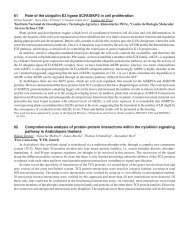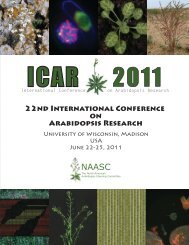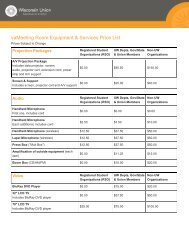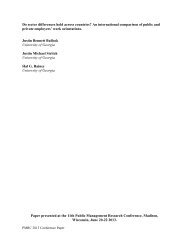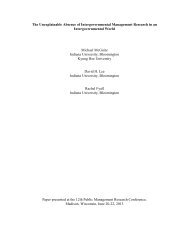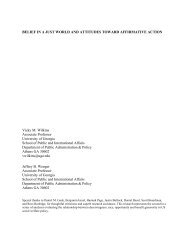PROGRAM & ABSTRACTS - Wisconsin Union - University of ...
PROGRAM & ABSTRACTS - Wisconsin Union - University of ...
PROGRAM & ABSTRACTS - Wisconsin Union - University of ...
Create successful ePaper yourself
Turn your PDF publications into a flip-book with our unique Google optimized e-Paper software.
Aging, Metabolism, Stress, Pathogenesis, and Small RNAs in C. elegans Topic Meeting 2012<br />
Enhancing N-glycosylation Through Activation <strong>of</strong> the Hexosamine<br />
Pathway Improves ER Protein Folding Capacity and Slows Ageing.<br />
Nadia Storm, Martin Denzel, Adam Antebi<br />
Max Planck Institute, Cologne, Germany<br />
Organismal ageing is the progressive loss <strong>of</strong> cellular homeostasis - including protein<br />
homeostasis, which comprises all processes maintaining a functional proteome. The endoplasmic<br />
reticulum (ER) is the site <strong>of</strong> protein synthesis for all secreted and membrane proteins, and<br />
the ER protein folding fidelity is closely monitored. Proper ER protein folding depends on<br />
chaperones, and requires N-glycosylation <strong>of</strong> the nascent peptide chain. Insufficient folding<br />
capacity triggers a stress response pathway, termed the unfolded protein response (UPR). The<br />
UPR signaling pathway is critical for normal C. elegans lifespan and for lifespan extension via<br />
the insulin signaling pathway. We hypothesized that improving ER stress resistance might result<br />
in lifespan extension. To identify novel mutations that improve ER protein folding we carried<br />
out a developmental drug resistance screen. After chemical mutagenesis, we selected for<br />
resistance to tunicamycin, which interferes with ER protein folding by inhibiting N-glycosylation.<br />
Next, we analyzed the lifespan <strong>of</strong> the tunicamycin resistant mutants. We found that increasing<br />
metabolite flux through the hexosamine pathway (HP) by gain-<strong>of</strong>-function mutations <strong>of</strong> the<br />
pathway’s key enzyme, glucosamine-fructose 6-phosphate aminotransferase (gfat-1), results<br />
in ER stress resistance and lifespan extension. The HP provides UDP-N-acetylglucosamine<br />
(UDP-GlcNAc) that is required in the first step <strong>of</strong> N-glycan synthesis, which is inhibited by<br />
tunicamycin. Tunicamycin resistance resulting from GFAT-1 hyperacitvation could be mimicked<br />
by feeding wild type C. elegans with HP intermediates and was DAF-16/FOXO-independent.<br />
GFAT-1 hyperactivation or exposure to UDP-GlcNAc precursors reduced the expression <strong>of</strong><br />
UPR target genes during ER stress, as seen in the gain-<strong>of</strong>-function mutants, suggesting an<br />
elevated threshold for UPR activation resulting from increased folding capacity. Increased HP<br />
metabolite flux further alleviated pathology in nematode models <strong>of</strong> proteotoxic stress, such as<br />
polyglutamine expansion, a model for Huntington’s disease. These data, together with GFAT-1’s<br />
high degree <strong>of</strong> conservation makes the HP a potential target for the treatment <strong>of</strong> age-related<br />
proteotoxic diseases in humans.<br />
Contact: nstorm@age.mpg.de<br />
Lab: Antebi<br />
26<br />
Session 4



